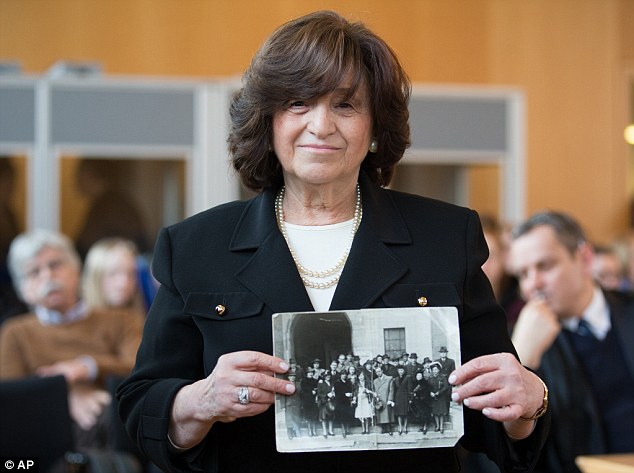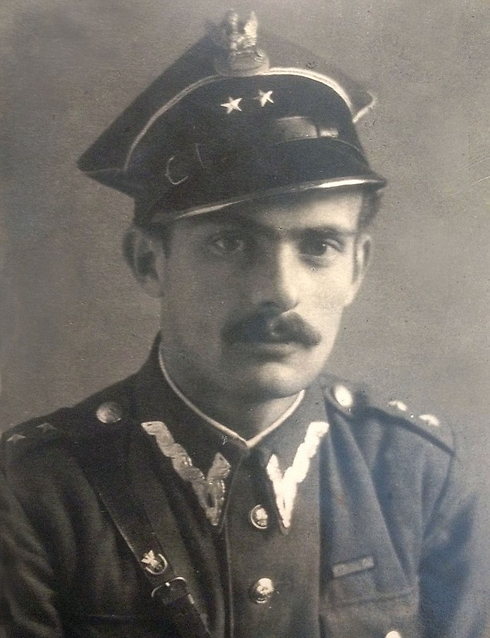
Stones with names of towns and villages, where the victims came from, are seen on the grounds of the former German Nazi Death Camp Treblinka (AP Photo/Alik Keplicz)
The following quote is from the news story which includes the photo shown above:
“Stones bear the names of hometowns and villages of Jews at the site of the Treblinka death camp in northeast Poland. About 875,000 European Jews were killed at Treblinka in a one-year span at the height of World War II. (Alik Keplicz, Associated Press file)”
According to Holocaust True Believers, Treblinka was an extermination camp where Jews were brought from Warsaw, and many small towns and villages in Poland, to be killed in gas chambers. Allegedly, their bodies were burned and the ashes were buried inside the camp. Years later, the alleged burial site was covered with stones, bearing the names of numerous places from which the Jews had been brought to Treblinka to be killed.
Holocaust deniers believe that Treblinka was a transit camp, where Jews were given a shower before being sent, to the east, across the Bug river into parts unknown.
Unfortunately, we will never know the truth, for sure, because the ground has been covered by stones in honor of the victims, so that no digging for evidence can be done.

Stones with names of towns from whence victims were brought to Treblinka

Stone monument at Treblinka surrounded by smaller stones which prevent digging
The photograph above shows the back side of the memorial tombstone at Treblinka. When the death camp was in operation, there was a narrow dirt path through a “tube” covered with tree branches which led to the gas chamber building in this spot. Notice the Menorah at the top of the tombstone.

Stone monument on the site of alleged gas chamber at Treblinka
Located on a knoll, at the top of a gentle slope, on the site of the former Treblinka extermination camp, is a large circular area with 17,000 stones of various sizes and colors set into concrete, which represents a symbolic cemetery, which is shown in my photos above.
When I visited Treblinka in October 1998, my private tour guide told me that 130 of the stones have the names of the cities or towns from which the victims were deported to the death camp. The guide told me that many relatives, of those who died here, come to the symbolic cemetery and are disappointed to find that their village is not named on any of the stones.
According to a pamphlet, which I purchased at the Visitor’s Center, “The great monument in Treblinka is a homage of the Polish people to those ashes lie under the concrete plates of the symbolic cemetery. It is one of the most tragic monuments of martyrdom in Poland.”
My tour guide informed me that the ashes of the 800,000 people, who were murdered at Treblinka, were dumped in this area and are now hidden underneath the concrete of the symbolic cemetery and under the grass and tiny flowers which cover the area.
One of the 17,000 symbolic stones represents the city of Kielce in central Poland, where 42 Jews were killed by a mob of Polish citizens in a pogrom on July 4, 1946, long after the Nazi occupation had ended.
Today Kielce is a modern industrial city with a population of 210,000, located between Warsaw and Krakow. In 1939, the Jewish population in the city was around 25,000, although until the early 1800s, Jews had been barred from living in the city. After the 1946 pogrom, many of the 300,000 Polish Holocaust survivors fled Poland and settled in other countries.
In 1968 there was more violence against the Jews in Poland, and almost all of the survivors were forced to leave.
Since my visit to Treblinka in 1998, I have learned that some tour guides now tell visitors that the number of 17,000 stones in the symbolic cemetery represents the highest number of Jews that were gassed in a single day when the camp was in operation. Others say that the number 17,000 represents the number of Jewish communities that were destroyed in the Holocaust.
According to the pamphlet which I obtained from the Visitor’s Center, the Treblinka memorial site was built between 1959 and 1963. In February 1960, the Warsaw Regional Council selected the designs of Polish sculptor Franciszek Duszenko and Polish architect Adam Haupt for the memorial stone and the Symbolic Cemetery.
According to the Warsaw Regional Council, the design of the symbolic cemetery would create a field of jagged stones that suggest a cemetery consisting of 17,000 stones with 700 of the stones inscribed with the names of the Jewish villages and communities in Poland that were obliterated by the Holocaust.

Symbolic cemetery at Treblinka has simulated burning pit in foreground

Treblinka stone commemorating victims from Sandomierz

Stone in honor of victims sent from Warsaw
The 800,000 bodies, which had allegedly been buried previously at Treblinka, were later dug up and then cremated on the orders of Reichsführer Heinrich Himmler, after he had visited the camp in 1943, according to Martin Gilbert. This project allegedly required three months of intense labor by 1,000 Jewish workers who were forced to perform this grisly task in an attempt to destroy the evidence of alleged mass murder at Treblinka.

Monument at Treblinka recreates burning pits where the bodies of Jews were burned
According to my tour guide, on my trip to Treblinka in 1998, the first gas chambers at Treblinka used carbon monoxide. The 10 new gas chambers used the poison gas known as Zyklon-B, according to the pamphlet which I purchased at the Visitor’s Center.
According to the True Believer version of history, Treblinka did not have delousing chambers; all the clothing taken from the prisoners was sent to the Majdanek camp to be disinfected with Zyklon-B before being sent to Germany. What? The Nazis couldn’t spare some of the Zyklon-B, used at Treblinka, to delouse the clothing?
A short distance farther up the slope, to the east of the gas chambers at Treblinka, was located the “cremation pyres” according to a map in the camp pamphlet which I purchased at Treblinka.
Strangely, none of the three Operation Reinhard extermination camps had a crematorium for burning the bodies of the 1.5 million Jews who were killed in these camps. Of the other five extermination camps which were in operation during the same period (Chelmno, Sobibor, Belzec, Majdanek and Auschwitz-Birkenau), only Auschwitz-Birkenau and Majdanek, which also functioned as forced labor camps, had crematoria with ovens for burning the bodies.
It is hard for me to believe that the Nazis did such poor prior planning of the extermination of the Jews in the death camps.
One of the 40 prisoners who escaped from Treblinka, and lived to tell about it, was Abraham Bomba, a Jew who was born in 1913 in Germany, but raised in Czestochowa, Poland. Bomba was one of the 1,000 Jews who lived in the barracks in a separate section of the Treblinka II camp and worked for the Germans who ran the death camp. Bomba was a barber and his job was cutting the hair of the victims inside the gas chamber, just before they were gassed. In 1990, he told about his experience in the camp in a video-taped interview for the US Holocaust Memorial Museum. The quote below is from the transcript of his interview:
“And now I want to tell you, I want to tell you about the thing…the gas chamber. It was, they ask me already about this thing. The gas chamber, how it looked. Very simple. Was all concrete. There was no window. There was nothing in it. Beside, on top of you, there was wires, and it looked like, you know, the water going to come out from it. Had two doors. Steel doors. From one side and from the other side. The people went in to the gas chamber from the one side. Like myself, I was in it, doing the job as a barber. When it was full the gas chamber–the size of it was…I would say 18 by 18, or 18 by 17, I didn’t measure that time, just a look like I would say I look here the room around, I wouldn’t say exactly how big it is. And they pushed in as many as they could. It was not allowed to have the people standing up with their hands down because there is not enough room, but when people raised their hand like that there was more room to each other. And on top of that they throw in kids, 2, 3, 4 years old kids, on top of them. And we came out. The whole thing it took I would say between five and seven minute. The door opened up, not from the side they went in but the side from the other side and from the other side the…the group…people working in Treblinka number 2, which their job was only about dead people. They took out the corpses. Some of them dead and some of them still alive. They dragged them to the ditches, and over there they covered them. Big ditches, and they covered them. That was the beginning of Treblinka.”
After each gassing, the Jewish workers at Treblinka had to clean up in preparation for the next batch of victims, according to Abraham Bomba. The clothing that had been taken off by the victims had to be removed and put into piles for sorting before being sent on the next empty transport train to Lublin. Everything was done with great efficiency in this assembly-line murder camp, and nothing was wasted. All of the clothes and valuables, taken from the Jews when they arrived at Treblinka, were sent to the Majdanek camp in a suburb of Lublin where everything was disinfected before being sent to Germany and given to civilians.
In his 1990 interview at the USHMM, Bomba described what happened next. Below is a quote from the transcript of his interview:
“People went in through the gate. Now we know what the gate was, it was the way to the gas chamber and we have never see them again. That was the first hour we came in. After that, we, the people, 18 or 16 people…more people came in from the…working people, they worked already before, in the gas chamber, we had a order to clean up the place. Clean up the place–is not something you can take and clean. It was horrible. But in five, ten minutes this place had to look spotless. And it looked spotless. Like there was never nobody on the place, so the next transport when it comes in, they shouldn’t see what’s going on. We were cleaning up in the outside. Tell you what mean cleaning up: taking away all the clothes, to those places where the clothes were. Now, not only the clothes, all the papers, all the money, all the, the…whatever somebody had with him. And they had a lot of things with them. Pots and pans they had with them. Other things they had with them. We cleaned that up.”































